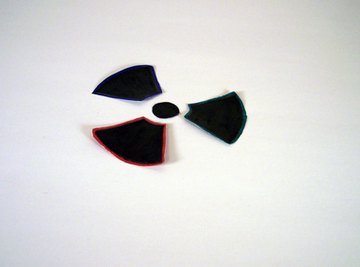
While radiation can refer to all forms of electromagnetic radiation, including light and radio waves, it's more often used when describing ionizing radiation--high-energy radiation that can ionize atoms, such as the radiation released by the decay of radioactive isotopes. X-rays, gamma rays, and alpha and beta particles are all forms of ionizing radiation. If present at sufficient levels, they can damage the health of humans and other animals.
Types
The energy of a photon of electromagnetic relation is given by the Planck-Einstein equation, E = hν, where E is energy, h is Planck's constant and ν is the frequency. From this equation, we know that the higher the frequency, the higher the energy.
Gamma rays and X-rays are at the top of the frequency spectrum and hence have high energy. When a photon of gamma or X-ray radiation strikes an electron or particle, it imparts its energy to its target. This transfer of energy can potentially remove electrons from atoms, or ionize them, and break chemical bonds between atoms.
Alpha and beta radiation are high-energy particles ejected by the decaying nuclei of unstable isotopes. They have an even greater ability to ionize atoms and disrupt chemical bonds, although they are more easily blocked than X-rays and gamma rays. Polonium 210 is one radioactive isotope that emits alpha particles; it made headlines in 2006 when former Russian KGB officer Alexander Litvinenko was poisoned with polonium.
Significance
When ionizing radiation strikes an animal cell, it can break chemical bonds inside molecules or form new bonds. The degree to which these changes harm the cell depends on which molecules are altered and the nature of these alterations. DNA damage is especially deleterious, since accumulated changes to cellular DNA can potentially lead to cancer.
Cells have internal repair mechanisms that can handle damage up to a certain point. However, if enough ionizing radiation strikes an animal cell or the damage is serious enough, the cell will die.
Size
Doses of radiation are generally measured using a unit called the gray or Gy, although a unit called the rad was preferred until quite recently and is still in fairly common use. A rad is equivalent to one centigray. Larger doses are potentially more lethal to animals. An acute dose of radiation is one rad or above; chronic exposure is repeated exposure to low doses over a long period of time.
Some animals seem hardier than others. A 2008 episode of the Discovery Channel program "Mythbusters" noted that, although cockroaches and flour beetles can tolerate higher levels of radiation than humans, these insects also will die when exposed to massive doses.
Effects
Animal cells that divide rapidly suffer the most serious damage during acute exposure. Cells in bone marrow and lymphatic tissue, for example, are especially vulnerable, as are the fast-dividing cells in the lining of the mammalian gastrointestinal tract. Massive doses of radiation can cause diarrhea, vomiting, internal bleeding, anemia, exhaustion, permanent sterilization and death.
Exposure to high levels can also cause permanent damage to cellular DNA that could potentially result in cancer. The effects in mice have perhaps been studied most extensively, since mice were used in many experiments with radiation.
Benefits
Ironically, some of the same properties that make ionizing radiation a potential hazard have made them useful in veterinary medicine. X-rays are a useful diagnostic tool since they can penetrate soft tissue quite readily but are absorbed by bones, which have a higher electron density.
X-rays can help vets find bone fractures and bladder stones and diagnose other disorders. The level of radiation used in a diagnostic X-ray is low enough that the risks are negligible. Just as in humans, radiotherapy is often used to treat cancer in dogs and cats. Beams of ionizing radiation are focused on the tumor in an effort to kill the cancer cells and shrink the tumor. Side effects typically include skin problems that may encourage the animal to scratch. While fatigue and nausea are possible side effects of radiotherapy in humans, these are unusual in cats and dogs.
References
About the Author
Based in San Diego, John Brennan has been writing about science and the environment since 2006. His articles have appeared in "Plenty," "San Diego Reader," "Santa Barbara Independent" and "East Bay Monthly." Brennan holds a Bachelor of Science in biology from the University of California, San Diego.
Photo Credits
radiation image by timur1970 from Fotolia.com
